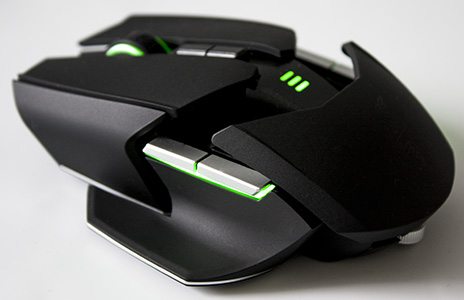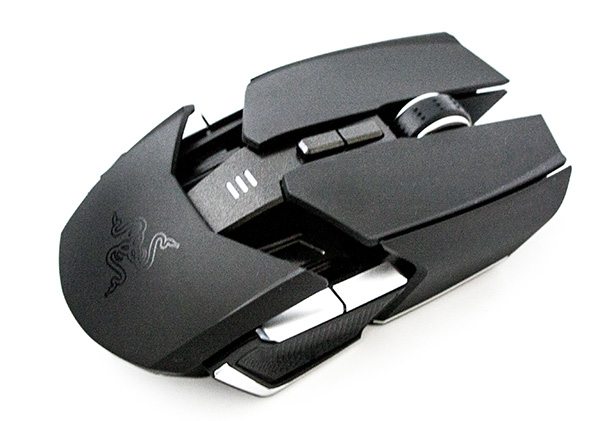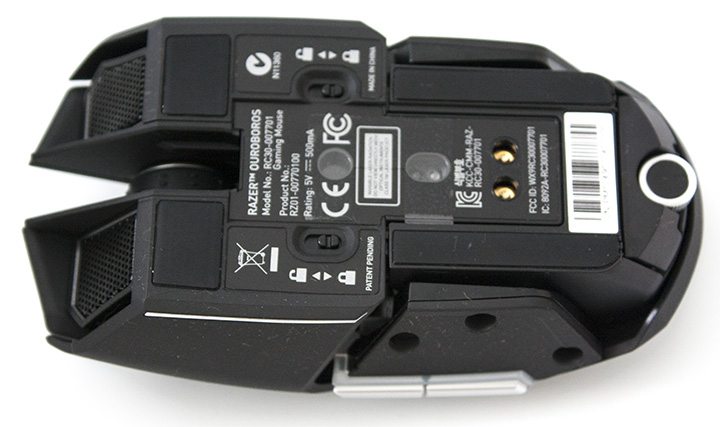Razer Ouroboros Wireless Gaming Mouse Review

It’s been a while since I last did a review on a Razer product, and since then there has been quite a few announcements regarding new products. Razer have hogged the spotlight at CES with their EDGE gaming tablet, which has overwhelmed the release of some of their gaming peripherals – but don’t fear, as I’m reviewing their latest gaming mouse today. Initially announced several months back – in fact, we first got a look at this mouse at Gamescom in Cologne back in September 2012, Razer have finally launched their flagship wireless gaming mouse: The Razer Ouroboros. The Razer Ouroboros is the latest wireless mouse to be released by Razer, which is also the first wireless ambidextrous gaming mouse by the company. The Ouroboros sits at the top of Razer’s product line, featuring all the latest technology to provide the best performance, so because of this, they have gone all out in both presentation and performance (and price!).
When it comes to gaming, we often look for the most comfortable mouse, with the best performance, all for the right price. I know Razer are known for their more expensive peripherals, but as long as the performance is there, then we shouldn’t have a problem. I’ve seen poor performing wireless gaming mice in the past, which have meant to be gaming grade – but always suffered from a bit of lag making it unacceptable in today’s fast paced games. Will the Razer Ouroboros be above average performance-wise in an already crowded market of gaming peripherals? Will it offer anything new? On paper the Ouroboros has a pretty impressive spec-sheet:
- Customizable ergonomics to fit all hand sizes and grip-styles
- 8200dpi 4G Dual Sensor System
- Gaming-grade wireless technology with dock
- Razer Synapse 2.0 enabled
- 11 programmable Hyperesponse buttons
- 1000Hz Ultrapolling / 1ms response time
- Up to 200 inches per second / 50g acceleration
- Approximate Size: 122 mm to 137 mm / 4.80″ to 5.39″ (Length) x 71 mm / 2.80″ (Width) x 42 mm / 1.65″ (Height)
- Approximate Weight: 115 g / 0.25 lbs. (without battery) to 135 g / 0.29 lbs. (with battery)
- Battery life: (Approx) 12 hrs (continuous gaming)
Just like the majority of Razer’s peripherals, this mouse runs off the controversial Razer Synapse 2.0 cloud based software, which requires an internet connection to use – a point that was recently brought to light by some of Razer’s fans. That said, who doesn’t have an internet connection right? Razer are renowned for their packaging on their premium products, so we were very eager to see what was in store for us with the Ouroboros – Let’s take a look.
Normally we cover the packaging here, but the Ouroboros was shipped in some special press packaging that won’t be found at retail. Inside the packaging we found all the components that will be available at retail; The Ouroboros mouse, a “gaming” dock, two sets of sides, a rechargeable battery, a USB cable and a rather unusual USB drive like device.

Let’s now take a closer look at the mouse. The Ouroboros by default have no sides attached to it as this is down to the gamer. Their are two different sets; a “wing” set and a “grip” set. The wing set are the sides used in the photo below. They cover more of the desktop and provide a rest for both your thumb and you pinky finger – although there is nothing to stop you using one from each set.
The mouse itself is of a very contemporary design – almost sport car like, which Razer did look at when designing the mouse. The mouse features the typical LMB, RMB and the scroll wheel, which has a series of 3 bumps to aid with the grip. Behind the scroll wheel are two additional buttons that control the DPI sensitivity. On each side are the thumb buttons – depending which hand you use it with. By default these control browser navigation. 
The other set of sides have a flatter design and feature a rubber section to provide better grip. The texture of the mouse is slightly rough and matte black in colour with silver being used to highlight small details.

At the back of the mouse is a small wheel which when turned raises or lowers the palm rest to suit the user’s needs. To alter the wrist rest position or to gain access to the battery compartment, there is a button around the small wheel, at the back of the mouse, which when pressed, allows you to move the rest up or down, or even remove it entirely if you wish to access the battery compartment.

Upon separating the two halves, a small switch needs to be pushed to open up the battery compartment. For the power, Razer have used a standard AA sized rechargeable battery rated at 2500mAh, so should produce around 16 hours of use.

Unlike most mice on the market, the Ouroboros features a 4G Dual Sensor System, which is essentially just an optical and laser sensor, all in one package. The dual sensors provide accurate and precise tracking, on top of adjustable lift of distance, giving you more control over your movement. The sensors give you a whopping 8200 DPI, although I have little idea what the most sensitive setting could be used for. The under side of the mouse is fairly well coated with smooth feet to ensure slick performance no matter what surface it is on. The lock buttons turn the side buttons on/off if you wish the disable one side. The two holes near the rear of the mouse are the charging contact points. You can also see the small wheel at the far right, which is used to adjust the height of the palm rest.

The charging dock is made of a similar material to the mouse, and even features green LEDs. The two metal extrudes, slot into the bottom of the mouse to charge it without having to connect the USB cable. It also acts as the wireless transmitter. The button located at the front of the mouse syncs the dock with the Ouroboros. Around the other side, there is the USB port for connecting the cable. The base of the charger dock is covered in a rubber like material which sticks the dock to any smooth surface.

The Ouroboros simply slots onto the two metal knobs, enabling you to charge the mouse when not in use. If the battery runs low and you still want to use the mouse then you can connect the USB cable directly to the front of the mouse and use it like a standard corded one. When connected to either the dock or USB cable the three LEDs located in the middle of the mouse indicate that it is charging.

Now that we’ve had a good look at the mouse, it’s time to take a quick look at the software to see how easy it is to customise such a complex mouse.









I belive they gave you that special case because you were doing a review. I at least didnt get mine in such a case, but the same way you buy the Razer Mamba, which comes in a see-through “plastic cube”. I would have liked getting a case like that though 🙂
I think it’s an awesome mouse this one! But is it comfortable? I would try it…
Synapse 2??? What the hell are they thinking? Who the hell wants to open ANOTHER online account just to store peripherals settings? I’ve just finished testing one and testing mice is a very subjective thing. I found it was not a bad mouse at all (for me) but it’s too expensive for what it is. The rule of thumb here is to try before you buy. If you’re throwing down the (not inconsiderable) sum Razer want’s for this moue, it’s imperative.
Nice post. Here you will find more details about
WiFi Mouse with its Features-Characteristics
Nice post. Here you will fine more details about
WiFi Mouse with its Features-Characteristics
http://technews-reviews.com/computing/wifi-mouse-with-its-features-characteristics